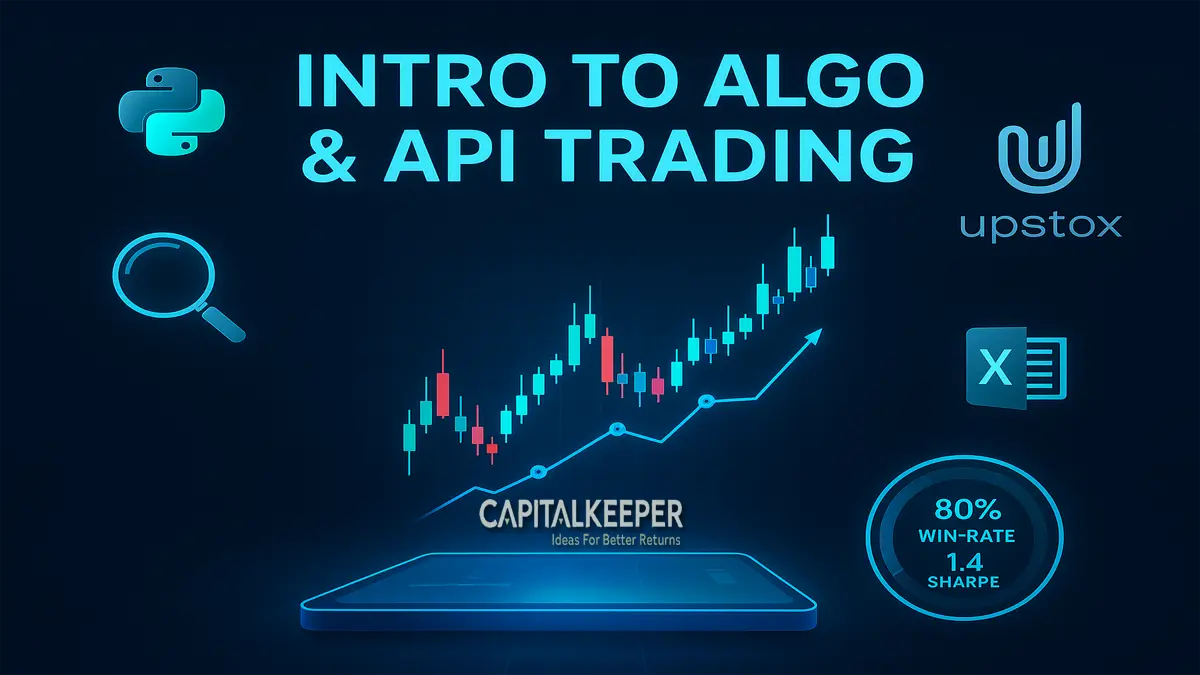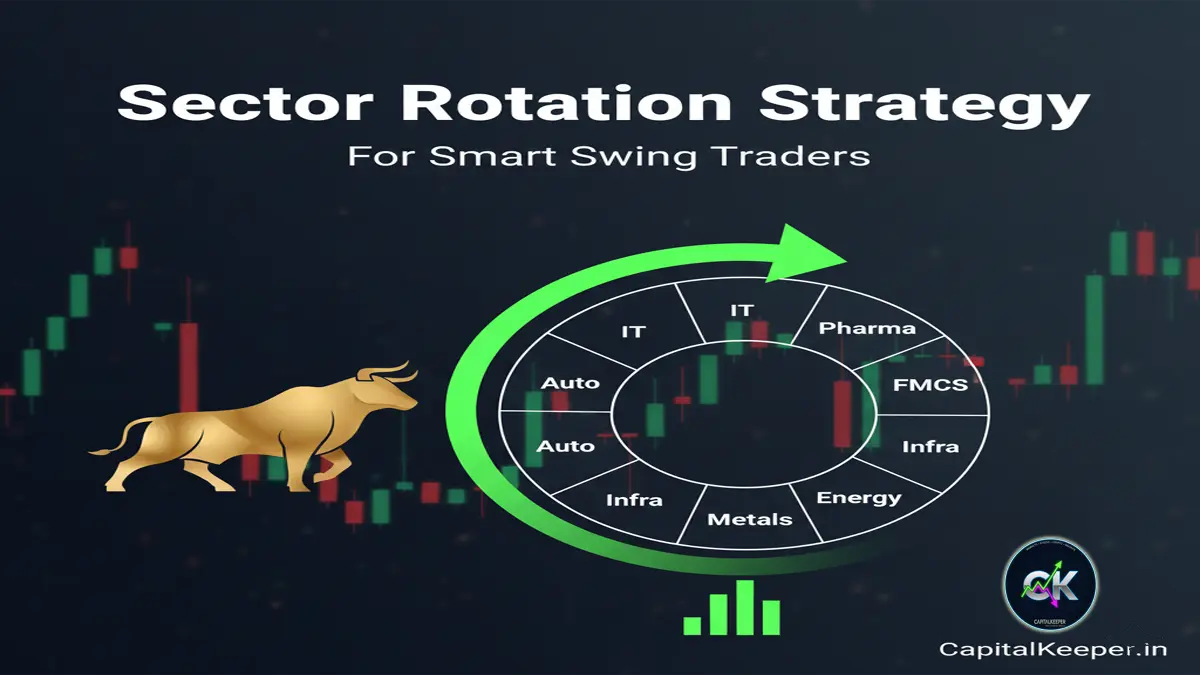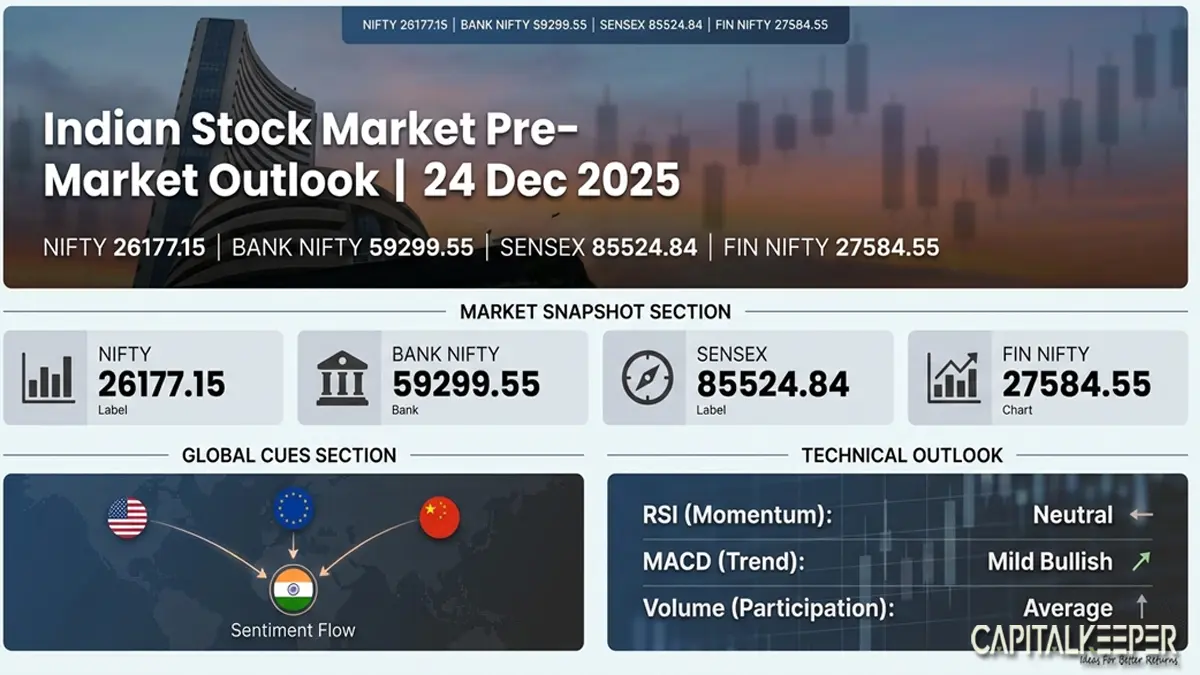Intro to Algo & API Trading – Automating Strategies with Python & Broker APIs : Day 4
By CapitalKeeper | Beginner’s Guide | Indian Equities | Market Moves That Matter
Learn the basics of Algo & API Trading in our Day 4 guide. Discover how tools like Zerodha Kite Connect & Upstox API enable automated stop-loss, stock scanning, and emotion-free trading strategies. Perfect for traders exploring semi-automation with Python.
Day 4: Intro to Algo & API Trading
In the world of trading, speed and precision often make the difference between consistent profits and missed opportunities. Gone are the days when traders manually sat in front of multiple screens, clicking buy and sell buttons all day. Today, algorithms (algos) and APIs (Application Programming Interfaces) allow traders to automate their strategies, cut out emotions, and execute with near-instant precision.
This marks Day 4 of our trading education series, and the focus is on how traders can transition from manual trading to algo-powered execution. If you’ve ever wondered how institutions trade at lightning speed or how retail traders can compete in such an environment, this is your entry point.
🔹 What is Algo Trading?
Algorithmic trading (or algo trading) is the use of computer programs to execute trades based on predefined rules. Instead of a human deciding when to enter or exit a trade, an algorithm monitors price data, technical indicators, and market events to make instant decisions.
For example:
- If the 50-day Simple Moving Average (SMA) crosses above the 200-day SMA, buy the stock.
- If the stock falls 2% from entry, exit immediately.
With algo trading, the system doesn’t hesitate, doesn’t second-guess, and doesn’t let emotions interfere. It simply executes what it has been programmed to do.
🔹 What is API Trading?
An API (Application Programming Interface) acts as the bridge between your trading account and your custom-built strategy. APIs provided by brokers like Zerodha Kite Connect or Upstox API allow your Python code, Excel sheet, or third-party platform to talk directly with the broker’s system.
This means:
- You can send buy/sell orders automatically.
- Retrieve real-time price data for 100+ stocks instantly.
- Manage your portfolio or check order history programmatically.
In simple words: API = the plug that connects your trading logic with the broker’s engine.
🔹 Why Algo & API Trading Matters
- Emotion-Free Trading
Humans panic when a trade goes against them or get greedy when profits rise. Algorithms don’t. They stick to the plan. - Speed & Efficiency
A script can scan the entire Nifty 500 stocks for breakouts in under a second—something impossible for manual traders. - 24/7 Monitoring
While you sleep, an algorithm can monitor global cues, price levels, and even crypto markets. - Backtesting to Live Execution
Once you’ve validated a strategy with backtesting (covered in Day 2), you can deploy it via API trading. This makes the journey from testing to execution seamless.
🔹 APIs Every Indian Trader Should Know
- Zerodha Kite Connect API
- One of the most popular APIs in India.
- Provides access to order placement, historical data, live quotes, and portfolio management.
- Works smoothly with Python libraries.
- Upstox API
- Affordable and beginner-friendly.
- Lets you stream live ticks, place trades, and analyze account data.
- Strong documentation for DIY traders.
Other brokers like Alice Blue (ANT API) and Fyers API are also growing in popularity, but Zerodha and Upstox remain the top picks.
🔹 Common Use-Cases of Algo & API Trading
- Automatic Stop-Loss & Target Placement
Instead of manually placing stop-loss orders, your algo ensures they are placed instantly after order execution. - Scanning 100+ Stocks Simultaneously
Algos can track breakouts, RSI levels, or candlestick patterns across multiple symbols in real time. - Strategy Execution Without Emotions
Once your SMA crossover or Bollinger Band strategy is coded, the system executes trades exactly as defined no fear, no greed. - Trading Beyond Market Hours
For markets like crypto, where trading never sleeps, API-driven bots can run 24/7. - Risk Management Automation
Portfolio hedging, rebalancing, and capital allocation rules can all be automated.
🔹 Example: Algo in Action
Let’s say you want to trade an SMA Crossover Strategy on Nifty 50 stocks.
Manual Way:
- Monitor 50-day and 200-day SMAs for every stock daily.
- When a crossover happens, place a buy order.
- Set a stop-loss and target manually.
Algo + API Way:
- Python script fetches Nifty 50 stock data via Zerodha API.
- If 50-SMA > 200-SMA, script sends a buy order automatically.
- A stop-loss (2% below entry) and a target (5% above entry) are placed instantly.
- The algo keeps monitoring and exits when conditions are met.
✅ Result: No missed signals, no hesitation, no human delay.
🔹 Getting Started: Semi-Automation First
Many beginners make the mistake of jumping directly into fully automated trading, which can be risky if the code has errors. Instead, follow this path:
- Backtest Your Strategy (Day 2 lesson).
- Paper Trade – Run your algo but don’t place live orders yet; just track results.
- Semi-Automation – Algo generates alerts (via email, SMS, or Telegram). You place trades manually.
- Full Automation – Once confident, allow the algo to place trades directly through APIs.
This step-by-step process ensures safety and confidence before handling real money.
🔹 Challenges & Risks in Algo Trading
- Overfitting in Backtesting – A strategy that looks perfect in historical data may fail in live markets.
- Technical Failures – API downtime, internet issues, or coding errors can cause missed trades.
- Broker Limitations – Most APIs come with daily request limits or subscription costs.
- Regulations – SEBI has guidelines around algo trading; compliance is important.
🔹 Tools & Languages to Learn
- Python → Libraries like Pandas, NumPy, TA-Lib, and Backtrader.
- Excel → Simple automation using macros for beginners.
- TradingView (Pine Script) → Great for semi-automation and alerts.
- Cloud Servers (AWS, GCP, DigitalOcean) → For running bots 24/7.
✅ Key Takeaway
Algo & API trading is not about building Wall Street-style high-frequency robots. Even retail traders can use them for basic automation like stop-loss placement, portfolio monitoring, and signal alerts.
The goal is to reduce human error and emotion from your trading process. Start small with semi-automation, and as confidence grows, let the code handle more.
Remember: Your strategy is the brain. Algo & API is just the execution arm. If your trading logic is sound, automation will only enhance your efficiency.
Final Thought
Day 4 highlights an important milestone for traders: the shift from discretionary manual trading to systematic, rule-based execution. While backtesting validates your idea, algo + API trading brings that idea to life in real markets.
Take it one step at a time backtest, paper trade, semi-automate, and then fully automate. This disciplined approach ensures you don’t just trade faster, but also trade smarter.
📌 For daily trade setups, technical learning, and smart investing tips, stay tuned to CapitalKeeper.in
📌 For more real-time updates, trade setups, and investment insights — follow us on [Telegram] and [WhatsApp Channel] subscribe to our newsletter!

Subscribe Now , Join Telegram the Crypto Capital Club, Get Free Crypto Updates
📌 Disclaimer
The content provided on CapitalKeeper.in is for informational and educational purposes only and does not constitute investment, trading, or financial advice. While we strive to present accurate and up-to-date market data and analysis, we make no warranties or representations regarding the completeness, reliability, or accuracy of the information.
Stock market investments are subject to market risks, and readers/investors are advised to conduct their own due diligence or consult a SEBI-registered financial advisor before making any investment decisions. CapitalKeeper and its authors are not liable for any loss or damage, direct or indirect, arising from the use of this information.
All views and opinions expressed are personal and do not reflect the official policy or position of any agency or organization. Past performance is not indicative of future results.By using this website, you agree to the terms of this disclaimer.
Ranjit Sahoo
Founder & Chief Editor – CapitalKeeper.in
Ranjit Sahoo is the visionary behind CapitalKeeper.in, a leading platform for real-time market insights, technical analysis, and investment strategies. With a strong focus on Nifty, Bank Nifty, sector trends, and commodities, she delivers in-depth research that helps traders and investors make informed decisions.
Passionate about financial literacy, Ranjit blends technical precision with market storytelling, ensuring even complex concepts are accessible to readers of all levels. Her work covers pre-market analysis, intraday strategies, thematic investing, and long-term portfolio trends.
When he’s not decoding charts, Ranjit enjoys exploring coastal getaways and keeping an eye on emerging business themes.
📌 Follow Ranjit on:
LinkedIn | Twitter/X | Instagram | ✉️ contact@capitalkeeper.in
















Leave a Reply